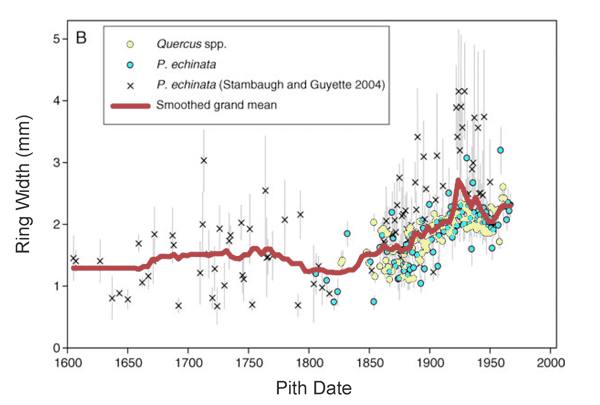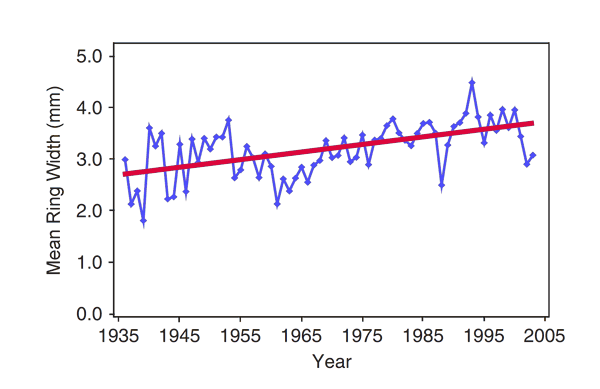The State of Earth's Terrestrial Biosphere:
How is it Responding to Rising Atmospheric CO2 and Warmer Temperatures?
Continental-Scale Analyses of Terrestrial Productivity: North America - Central USA
Turning to the central United States, working with two species of oak (Quercus velutina Lam. and Quercus coccinea Muench.) and one of pine (Pinus echinata Mill.) in the Ozark Mountains of Missouri, USA, Voelker et al. (2006) report that since 1850 the stem growth of the three species has risen "coincidently with increases in atmospheric CO2," such that the overall trend in ring-width in recent years is "nearly two times that" experienced prior to 1850 (Figure 23). In addition, they note that the "long-term increases in radial growth appear unrelated to historical disturbance levels for the region, to long-term changes in relevant climatic variables, or to productivity of sites sampled." And based on these findings, the four Department of Forestry researchers from the University of Missouri suggest that as the atmosphere's CO2 concentration continues to rise, aided by continued nitrogen deposition, it will likely "stimulate further increases in the rates of stand development and carbon storage."

Figure 23. Mean ring width responses by pith date calculated across 11 equally spaced cambial ages from 1 to 50, for randomly sampled oak and pine trees in the Ozark Mountains of Missouri, USA. The means for P. echinata (Stambaugh and Guyette 2004) were calculated from three cambial ages but were shifted to the pith date for accurate intercomparisons among data sets (see Voelker et al., 2006). The smoothed grand mean was calculated across each of the closest 14 ring widths. Adapted from Voelker et al. (2006).
Introducing their study of the subject, Cole et al. (2010) write that quaking aspen (Populus tremuloides Michx.) is a dominant forest type in north-temperate, montane, and boreal regions of North America," stating that it is, in fact, "the most widely distributed tree species on the continent," while noting that aspen -- and related poplars -- are "quintessential foundation species (Ellison et al., 2005), shaping the structure and function of the communities and ecosystems in which they occur (Whitham et al., 2006; Schweitzer et al., 2008; Madritch et al., 2009)." This being the case, they felt it important to attempt to determine how this keystone species may have responded to the increase in atmospheric CO2 concentration that has occurred over the past several decades, especially within the context of the climatic changes that occurred concurrently.
To accomplish this goal, the four researchers collected branches from 919 trees after their leaves had dropped in the fall, obtaining samples that represented 189 genets or clones (five trees per clone) at eleven sites distributed throughout three regions of Wisconsin (USA). The sampled trees ranged from 5 to 76 years of age and came from second-growth unmanaged forests south of the areas defoliated by forest tent caterpillars in 1980-1982, 1989-1990 and 2001-2002. In addition, they recorded trunk diameter at breast height for each sampled tree, which parameter, in their words, "is very highly correlated with total biomass in aspen," citing the work of Bond-Lamberty et al. (2002).
So what did the Minnesota and Wisconsin scientists learn? First of all, they determined that "age-specific ring width increased over time," and that "the greatest increase occurred for relatively young trees, so that young trees grew faster in recent years than did young trees several decades ago." During the past half-century, for example, they found that the growth of trees 11-20 years old rose by 60% (Figure 24). In addition, they observed that "rising CO2 causes ring width to increase at all moisture levels, apparently resulting from improved water use efficiency," so that "the overall increase results from historical increases in both CO2 and water availability." And when they separated out the impacts of the two factors, they found that "the effect of rising CO2 had been to increase ring width by about 53%," as a result of "a 19.2% increase in ambient CO2 levels during the growing season, from 315.8 ppm in 1958 (when CO2 records began) to 376.4 ppm in 2003."

Figure 24. Mean ring width of quaking aspen trees sampled in Wisconsin, USA. Adapted from Cole et al. (2010).
This is a truly remarkable finding; and Cole et al. comment that "the magnitude of the growth increase uncovered by this analysis raises the question of how much other major forest species have responded to the joint effects of long-term changes in CO2 and precipitation.
The U.S. Northern Great Plains is another area where woody plants have responded positively to the 20th-century increase in atmospheric CO2 by expanding their ranges, and that expansion has led to greater benefits beneath the soil as well. According to Springsteen et al. (2012), "changes in soil attributes under woody vegetation have been documented in the arid grasslands of the southern Great Plains, including increases in soil carbon and nitrogen," citing the work of Reynolds et al. (1999), Hibbard et al. (2001, 2003), McCulley et al. (2004), Schade and Hobbie (2005) and Liao et al. (2006). In their own investigation into such changes, Springsteen et al. examined near-surface (upper 15 cm) soil biogeochemistry along a 42-year (1963-2005) chronosequence, which encompassed grassland, woodland, and grassland-woodland transition zones in a northern Great Plains grassland at the USDA-ARS Northern Great Plains Research Laboratory near Mandan, North Dakota (USA), in order to determine the influence of woody plant expansion on soil carbon and nitrogen contents.
According to the four researchers, total soil carbon content rose by 26% across the chronosequence from grassland to woodland within the 0-15 cm soil depth, while total soil nitrogen content rose by 31%. And they add that the rate of woody shrub expansion from 1963 to 1988 (25 years) was ~1,800 m2 per year at their study site, while from 1988 to 2005 (17 years) it was ~3,800 m2 per year, or just a little more than doubled. It would thus appear that soil carbon sequestration driven by woody-plant invasions of grasslands (which are driven to a significant degree by the ongoing rise in the air's CO2 content), as well as the increases in soil nitrogen content required to sustain them, are growing ever greater with the passage of time.
Lastly, in a vastly different type of study based on a 48-year record derived from an average of 17 measurements per year, Raymond and Cole (2003) demonstrated that the export of alkalinity, in the form of bicarbonate ions, from the USA's Mississippi River to the Gulf of Mexico had increased by approximately 60% since 1953. "This increased export," as they described it, was "in part the result of increased flow resulting from higher rainfall in the Mississippi basin," which had led to a 40% increase in annual Mississippi River discharge to the Gulf of Mexico over the same time period. The remainder, however, had to have been due to increased rates of chemical weathering of soil minerals.
What factors might have been responsible for this phenomenon? The two researchers noted that potential mechanisms included "an increase in atmospheric CO2, an increase [in] rainwater throughput, or an increase in plant and microbial production of CO2 and organic acids in soils due to biological responses to increased rainfall and temperature." But it has also likely changed as a result of the increase in terrestrial plant productivity that is produced by the increase in the aerial fertilization effect provided by the historical rise in the air's CO2 content, which also leads to an increase in plant and microbial production of CO2 and organic acids in soils. And this phenomenon should have led to an increase in Mississippi River alkalinity equivalent to that which Raymond and Cole observed since 1953.
In light of the findings presented above, it would appear that the late 20th-century rise in temperature and CO2 has also improved the productivity of plant communities in the central region of the U.S., notwithstanding climate-alarmist concerns to the contrary.




